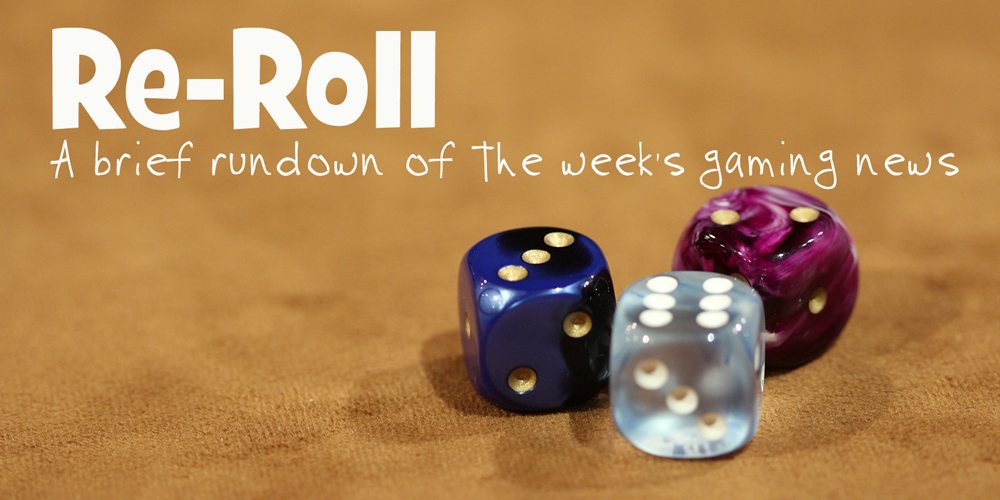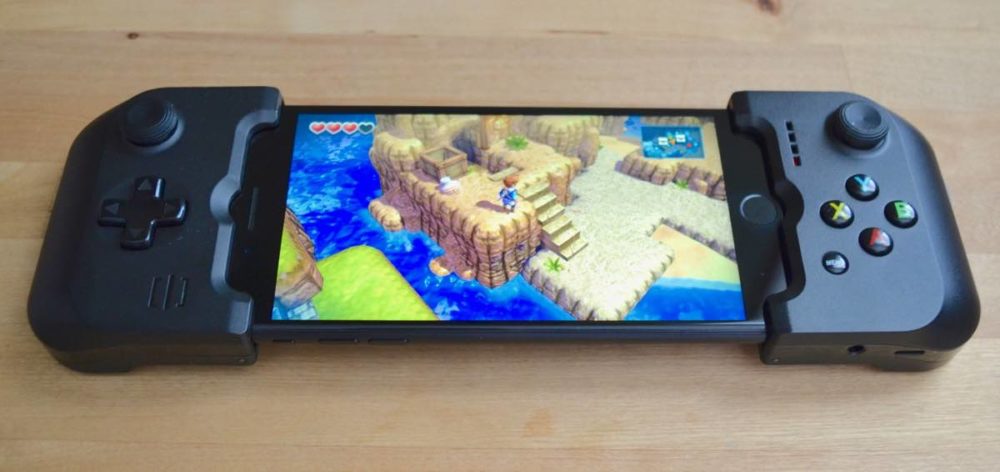I’m not a fan of beaches. Part of it is that I burn quite easily. Part is that I get bored even more easily. And then there’s the sand. Anakin was right about sand. I am, however, married to a woman who would move to the beach if given the chance. Thankfully, we now have a game that lets me do the thing I like–be inside, sunburn and sand free, playing games–with a theme that makes her wish she was on the beach.
What Is Santa Monica?
Santa Monica is a game for 2-4 players, ages 14 and up, and takes about 45 minutes to play. It’s currently available on Amazon and from your friendly local game store.
Note: As an Amazon Associate I earn from qualifying purchases.
Santa Monica was designed by Josh Wood and published by AEG, with illustrations by Jeremy Nguyen.
Santa Monica Components

Inside the box, you’ll find:
- 78 Feature cards
- 4 Reference cards
- 6 Starting feature cards
- 4 Sand dollar tiles
- 3 Starting objective tiles
- 68 Wooden meeples – 30 locals, 30 tourists, 8 VIPs
- 28 Footprint tokens
- 25 Wooden sand dollars
- 4 Sand dollar multipliers
- 1 Wooden food truck
- 1 Wooden foodie meeple
- 1 Start player token
- 1 Scorepad
- 1 Rulebook
The components in the game are, without exception, gorgeous. They perfectly encapsulate the game’s theme.
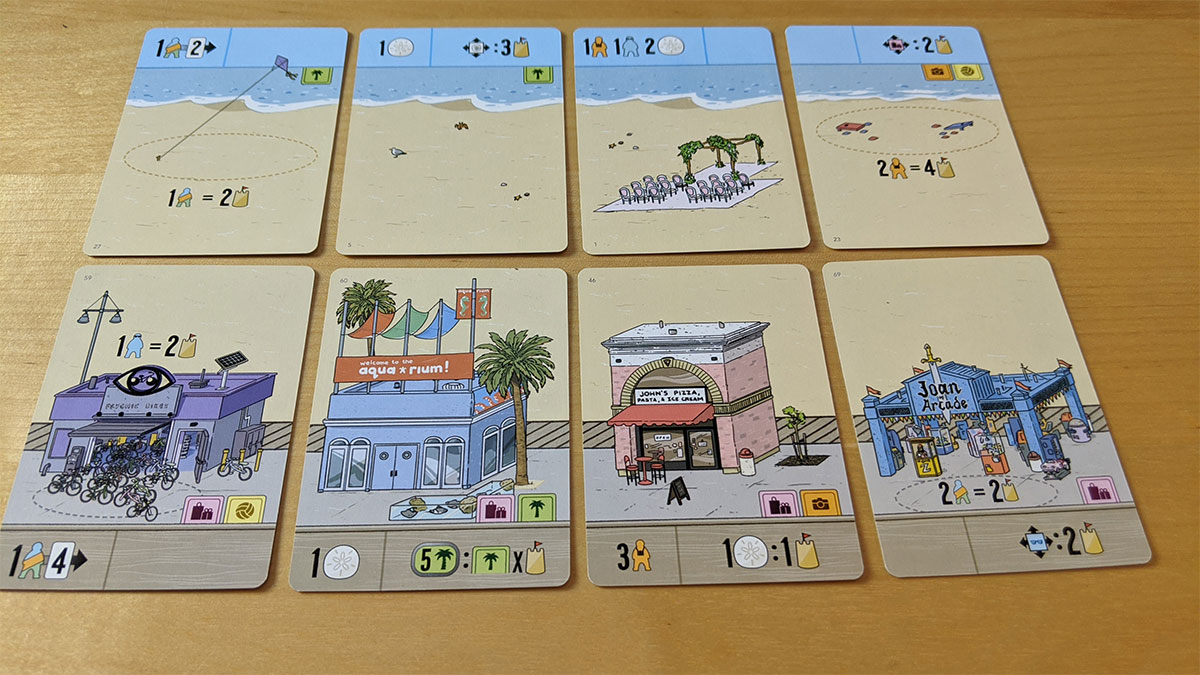
The feature cards plastic-coated poker-sized card that represent either beach or boardwalk locations. Each is unique. The boardwalk cards are mostly buildings.

Some are exactly the kinds of businesses you’d find on a stroll through the real Santa Monica (for those who aren’t from LA, you can get to Santa Monica from anywhere in the country by getting on I-10, and heading west until you run out of land. When you do, you’re there.) Others contain the kinds of subtle jokes that many games include–for example, one card shows a business called “Love Birds Souvenirs and Gifts”. That shop has those spikey things on its roof to, ironically, keep away birds, resulting in the attached building next door to be inundated with birds, and thus abandoned with a large “For Lease” sign on top.

The beach cards show empty beach, or beach games like volleyball, or surfboards and towels, or lifeguard stations. Or, the one with the shark warning sign and a fin in the water. There are also a whole bunch of weddings, because I guess that’s a thing people do?
Each card, whether beach or boardwalk, also has indicators on them as to what meeples will come to the card when it’s played, and what rewards, if any, players earn when playing the card. While the main focus of the card is the beach or boardwalk art, the cards are designed well and so the gameplay features are easy to see and don’t get lost in the art.

The starting tiles are thick cardboad pieces that are the width of the cards, but twice the height, as each covers both a boardwalk and a beach location. They all have starting meeples, along with the way the player will score in the end with these tiles.

The sand dollar tiles are the same thick cardboard, and provide variety and replay value. Each is double-sided, providing for a large number of possibilities when they are played. The scoring objective tiles are the same, ensuring that the scoring objectives change from one play to the next.

The remaining cardboard components are pretty straight-forward: the starting player token is simply a cardboard sea gull, the footprint tokens allow players to mark where their VIPs have been, while the sand dollar multipliers solve the perpetual problem in games of running out of a key component.

That component is the sand dollars, which provide the currency in the game. There wooden pieces are easy to handle and have the distinctive sand dollar pattern screened on them.

The largest set of wooden components are the meeples. They aren’t the normal meeple shape, but instead are a slightly less abstract human. They come in three colors–light blue for locals, orange for tourists, and green for VIP. Each set also has slightly different art screened on to them: the locals have sunglasses on their face, while the tourists have a camera hanging from their neck. The VIPs are the exception, and were left plain.

And then there’s the foot truck and the foodie. Both are pink wood pieces. The foodie is the same shape as the other meeples, but about twice as big, and the food truck has a serving window screened on one side.

Finally, there’s the scorepad. Games that can have complex scoring from multiple sources that include a scorepad always get bonus points in my book.
How to Play Santa Monica
You can download a copy of the rulebook here.
The Goal
The goal of the game is to create the best waterfront possible, thus earning the most points.
Setup
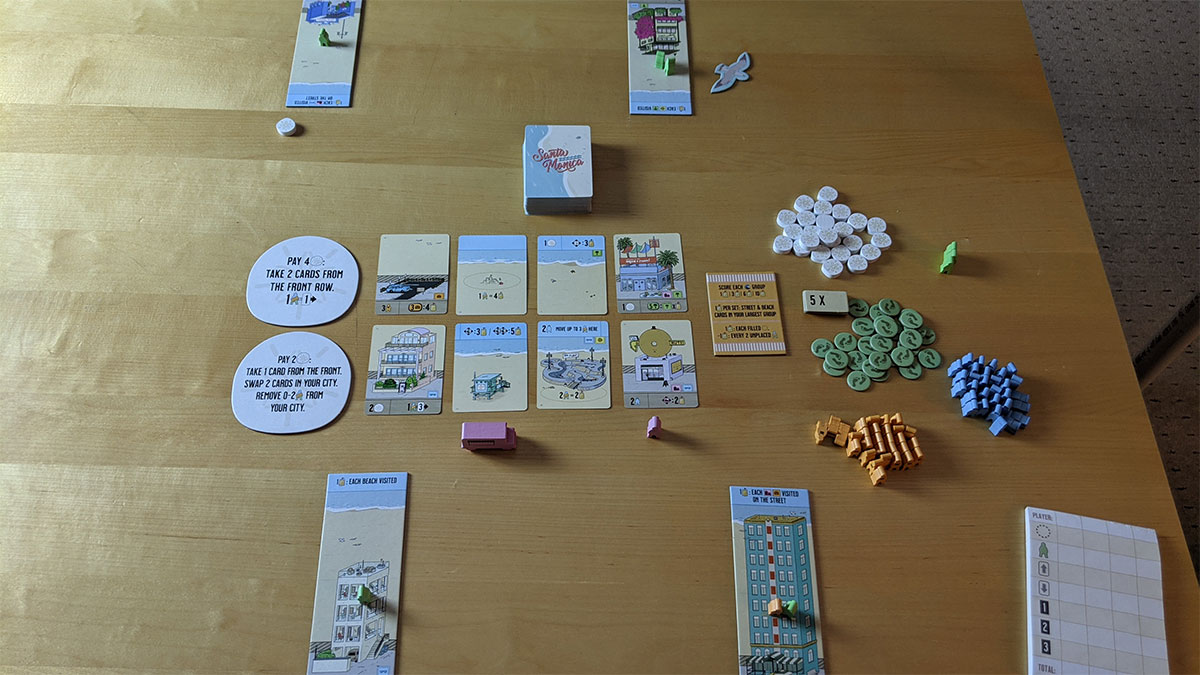
To setup the game, you first shuffle the feature cards, then deal out 2 rows of 4 cards each, creating a “front” row and a “back” row of the display. The remaining cards are placed in a face-down deck above the back row.
Then, randomly select 2 of the 4 sand dollar tiles and place them next to the display. Return the other two to the box. Randomly select one of the three scoring tiles and place it on the other side of the display.
Place the meeples into separate piles, along with the sand dollars, multipliers, and footprints.
According to the rules, the person who last visited a beach becomes the first player and gets the starting player token, but you know, use whatever method makes you happy.
Randomly select starting feature tiles equal to the number of players and place them on the table. Then, in reverse player order, each player selects one starting feature tile and places it in front of them. Give the player the bonuses for their feature tile, which are indicated in the bottom left corner of the tile and will be some number of meeples and/or sand dollars.
The last player in turn order places the food truck under any of the four rows on the display, and then places the foodie two spots away from that.
Gameplay
On each player’s turn, they will take three actions in order:
- Select and place a feature card on their city
- Take placement actions based on the feature card
- Refresh the display

The first action, selecting a feature card, is where most of the strategy of the game lies. The display has a front row and a back row. On their turn, players can select any card from the front row for free.
However, they can instead choose to use the ability on one of the sand dollar tiles, which may allow them to select a card from the back row, or two cards, or something else. To do this, they have to pay the number of sand dollars as indicated on the tile.
If the food truck is under the card the player selects, they also take a sand dollar from the supply, and then move the food truck one space to the right, wrapping around the display if needed. If the foodie is below the card, the player can move any one meeple one space in their city (see below for more on moving meeples), and then they move the foodie one space to the right.
If the foodie catches up to the food truck, nothing happens right away (because we all know food trucks tend to be slow). However, the next time someone draws the card above the food truck and foodie, they can either combine the awards, taking a sand dollar and moving a meeple, or they can double up either, taking two sand dollars or making two moves (either moving one meeple twice, or two meeples once.) After that, the food truck moves two spaces to the right, leaving the foodie behind to try to catch up again.
This mechanic provides an incentive to draw a card that might be less-than-ideal, to keep the cards rotating so that the game doesn’t get stuck with eight cards no one really wants. While this is of course very common in games like this, I like that Santa Monica added a thematically-appropriate way to do it, rather than just having something trigger discards.

Once a card has been selected, it must immediately be placed in the player’s city. Each city has two rows–a beach and a boardwalk–and cards can only be placed in the appropriate area. Cards must also line up with either the starting feature tile or at least one ther card. Cards can be played to either side of the starting tile. Note that card need only line up with one other card, so it’s possible to have a beach that is longer than a boardwalk, or vice-versa. It’s also possible to have a long string of beach cards, and then place a boardwalk card below, leaving a gap in the boardwalk. Or, again, vice-versa.

Cards may also display one or more icons showing what type of location they represent. There are six such tags: local spots (blue, with sunglasses), tourist spots (oragne, with a camera), businessess (pink, with two packages), sports (yellow, with a volleyball), nature (green, with a palm tree), and ocean (white, with a wave.) Any of the types can appear on beach cards, but the waves never appear on the boardwalk (because that would be bad.)
Once played, cards cannot be moved, unless the game includes the one sand dollar tile that allows players to swap the position of two cards in their city.

After placing the card, the player then takes their placement actions. Each feature card has a set of icons that show these actions. The boardwalk cards have the icons in the lower left corner, and the beach cards, the top left. Generally speaking, the actions fall into two categories: gaining tokens, or moving people.

If the card shows either a sand dollar with a number, or one or more people, or both, then the player gains those from the supply. Sand dollars are placed in front of the player can be used in later turns to active the abilities of the sand dollar tiles, and are also worth points at the end of the game. People must be placed on the card that was just played.
If the card shows a number, a color of a meeple, and a movement number, then the player may move meeples around in their city. The displayed number of meeples that match the color on the played card can be moved from anywhere in the city up to the movement number. Each card, along with the start tile, counts as one space. Meeples can freely move between the boardwalk and the beach. Each meeple is moved independently–groups of meeples do not need to stay together.
Some of the cards show a multi-colored meeple, allowing movement of meeples of any color.
Moving meeples has two goals. First, you want to move your VIP meeples around the city to achieve the goal stated on your starting tile. Each time a VIP moves onto a card with the appropriate location tag, the player places a footprint token on that card. At the end of the game, they may score points for these visits.

Locals and tourists are moved to place them into activity rings, which appear on both beach and boardwalk cards. Each activity ring has a set number of meeples that can be in it. Some of them need to be specific colors, while others can be any color. Any meeples on a card that exceed the limit on the activity ring, along with any on cards without rings, are unplaced. At the end of the game, players will score points for filled activity rings, and may lose points for any unplaced meeples.
Once the card has been placed and the actions have been taken, the active player refreshes the display by taking the card from the bottom row and moving it into the front row position where the drawn card was, and then drawing a new card from the deck and placing it in the bottom row. This way, player always know what is coming, and also, have another strategic move to consider–if you take a particular card, you make a potentially valueable card available to your opponent, so sometimes, you might choose a less advantageous card so as to prevent your opponent from getting the card they want, or possibly, trying to leave a card you want in place, hoping it’ll be avaliable on your next turn.
Game End
The game ends when one player has 14 feature cards played in their city. You finish the round so that everyone has an equal number of turns, and then begin scoring. Note that since in most cases everyone plays one card each turn, most of the time, the game is not a race to someone getting 14. In fact, in some cases, the sand dollar tiles that allow for placement of more than one card–the only way everyone wouldn’t have exactly the same number played–aren’t even in the game.
According to the score sheet, the first thing to score are the activity rings. These are pretty straight-forward: any ring that has the exact number of required meeples scores the points indicated.

Next, score footprints, based on the starting tiles. Remember, footprints are earned by moving the VIPs during the game.
Next, beach cards should be scored (this is indicated by the up arrow on the scorepad. Those are followed by the boardwalk cards (the down arrow.) This is the most complicated part of scoring.
Most feature cards provide some way that the card will score. Some are based on adjacency: the player gains the points indicated if the card is adjacent orthogonally to at least one card that contains the given location tag, or a sand dollar or meeple icon.

Chains are the even more complex scoring method, but the place were careful planning can net lots of points. Like adjacency, the card will show a location tag and a point value. However, in this case, points are earned as long as a chain of the location icons, with at least the given length, are in the city. Chains do not have to be straight lines, but they cannot be broken.
Some chains have an additional scoring condition that awards points based on the number of cards with the tag.
Note that quite a few cards contain more than one tag. Those would be included in each and every potential chain which the card was part of.
Finally, some cards award points for any unspent sand dollars. If you have more than one of these, each sand dollar you have counts for each card.
After scoring the city, players score for the three objectives on the chosen scoring card. Note that some of these objectives subtract points for unplaced meeples. However, the objective card is chosen at the beginning of the game and is visible througout, so this should never come as a surpise.
Once everyone tallys their points, the player with the highest score wins. If there’s a tie, the tied player with the more remaining sand dollars wins. If still tied, the victory goes to the person with the longest chain. And finally, and I promise this really is in the rules, “the next player to write ‘I WIN’ into the sand is the winner.”
Regardless, everyone got to spend an hour thinking about the beach without actually having to go there, so really, everyone wins.
Why You Should Play Santa Monica
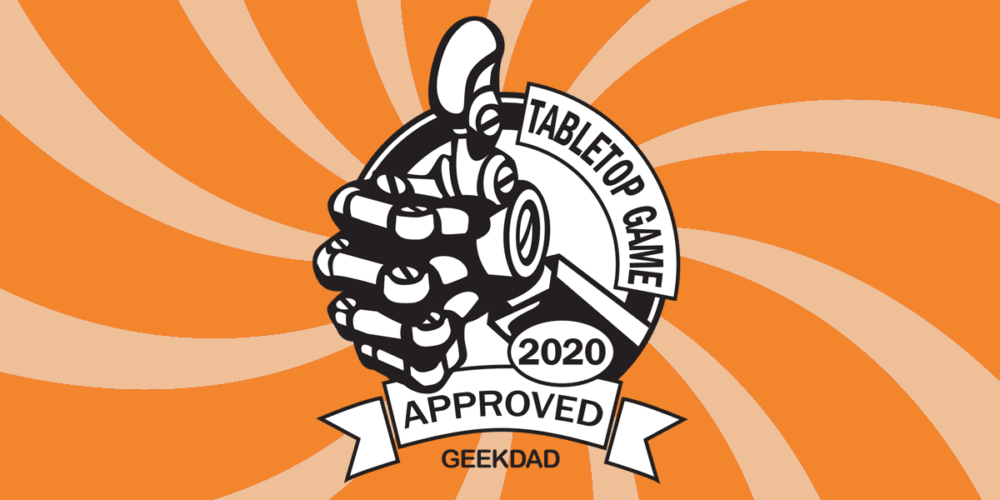
Santa Monica is GeekDad Approved!
Santa Monica is one of those games that, out of the box, looks pretty simple. But as soon as you start playing, you realize is has tons of hidden depth. On each turn, you have a ton of potential decisions to make: “I really need that card because it has a location tag I need to continue a chain, but it also gives me too many meeples that I really don’t need, so maybe I should take that card, which doesn’t help my beach too much but does let me move some meeples around, except if I take it, then my son gets the card above it for free, and I know that will really help him, so maybe I should take that other card instead since it’ll give me some sand dollars, and on my next turn I’ll be able to afford to play two cards…” And yet, there are really only four cards to choose from, so it’s tough to get too deep into analysis paralysis.
It’s also a fairly forgiving game; unlike a lot of other card (or tile) placement games, a single mistaken placement of a card isn’t likely to doom your changes, since there are enough other ways to score that losing a few points by a mistake probably can be made up for with other placements.
And yet despite the point salady-potential, most of our games are quite close–the winner is usually less than 10, and often less than 5, points ahead.
Games that have players build their own tableau often suffer from a lack of player interaction, and can quickly become multi-player solitaire affairs. Santa Monica has no direct interaction at all–at no point can you do anything to an opponent’s city–and yet drawing from the shared, very small pool of cards creates a ton of interaction, with each player looking intently at the currently active player’s selection, all secretly hoping they take (or maybe don’t take) just the right card to open up an opporuntity.
And maybe it’s that lack of direct interaction, but perhaps just the relaxed beach theme, but there’s something about Santa Monica that just makes it a much less intense game. It really is like a lazy afternoon sitting on the beach, but without the sunburn and the sand everywhere.
Regardless, Santa Monica is a very fun game that should find a place on almost anyone’s shelves. That’s why I’ve given it the GeekDad Approved seal–it really is one of my favorite games of 2020.
Click here to see all our tabletop game reviews.
![]() To subscribe to GeekDad’s tabletop gaming coverage, please copy this link and add it to your RSS reader.
To subscribe to GeekDad’s tabletop gaming coverage, please copy this link and add it to your RSS reader.
Disclosure: GeekDad received a copy of this game for review purposes.




